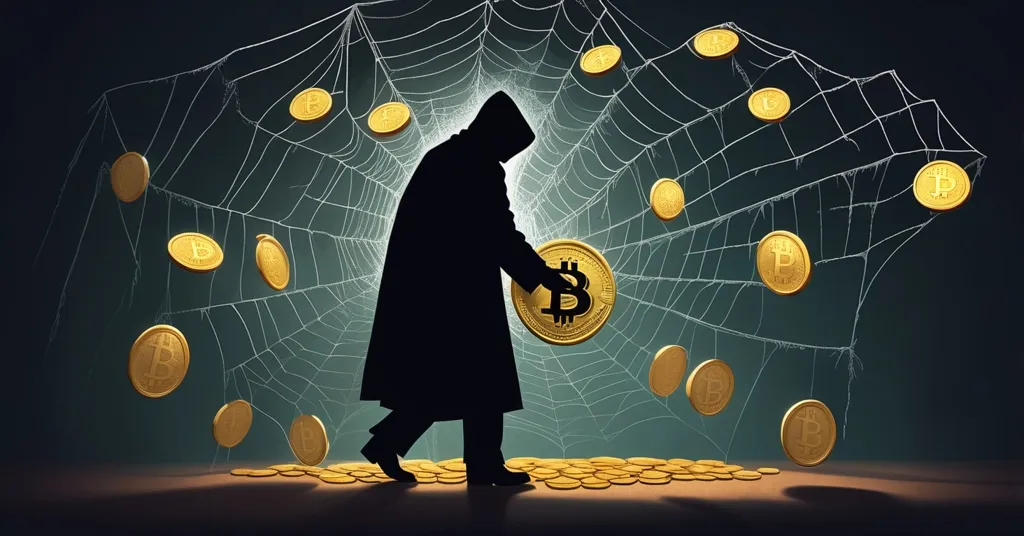Silk Road Bitcoin Wallets Move 3,421 BTC After 10 Years: Ulbricht’s Legacy and Market Impact

Silk Road’s Dormant Bitcoin Wallets Awaken: 3,421 BTC Moved After Over a Decade
On May 5, two Bitcoin wallets linked to the Silk Road, a notorious darknet marketplace, moved 3,421 BTC valued at approximately $322.5 million after being dormant for over a decade. This significant event not only reignites interest in the Silk Road’s legacy but also raises questions about the future of these long-dormant funds.
- 3,421 BTC moved from Silk Road-linked wallets
- First activity since July 2013
- Funds transferred to new, inactive addresses
- Minimal transaction fees suggest no rush to liquidate
- Connected to Ross Ulbricht, recently pardoned
These wallets, which had been silent since their activation in July 2013, suddenly transferred their holdings in two separate transactions. The minimal fee of 0.000105 BTC suggests there was no urgency to convert these assets into cash, hinting at a strategic move rather than a fire sale. It’s like tipping a digital waiter a penny after a $322.5 million meal. As the funds now sit in new addresses that have yet to show further activity, speculation abounds about their ultimate purpose.
The origin of these Bitcoin traces back to the Silk Road, a hidden online market where goods could be bought and sold anonymously. Launched in 2011, it became a symbol of the darker potential of Bitcoin, enabling transactions that ranged from the mundane to the illegal. Sani, the founder of Timechain Index, confirmed their historical connection, stating:
After checking some of the origins, they linked back to [the] Silk Road, withdrawn during 2012.
The movement of these funds comes on the heels of a significant event for Silk Road’s founder, Ross Ulbricht. Earlier this year, Ulbricht received a presidential pardon from Donald Trump, reigniting discussions about his case and the broader implications for cryptocurrency. This pardon followed over a decade of imprisonment for Ulbricht, who was convicted in 2015 for his role in running Silk Road.
The Bitcoin community’s response to Ulbricht’s pardon was swift and supportive. Kraken Exchange contributed a significant donation of $111,111 BTC to Ulbricht’s fund at FreeRoss.org, showcasing the community’s alignment with Ulbricht’s cause. This support underscores the philosophical and ideological ties many in the crypto space feel with the principles that Silk Road represented.
Adding another layer to the narrative, Conor Grogan, Director at Coinbase, recently identified around 430 BTC in additional wallets linked to Ulbricht, which had remained untouched for over 13 years. Grogan’s findings suggest that Ulbricht may still have access to significant funds, despite years of legal battles and incarceration.
The Silk Road’s impact on the cryptocurrency world cannot be overstated. Its eventual shutdown by the FBI in 2013 marked a pivotal moment in the early days of cryptocurrency, drawing both regulatory scrutiny and fascination with the possibilities of decentralized finance. While the Silk Road brought Bitcoin into the spotlight, it also cast a shadow over its potential for illicit use. Is it time for the crypto community to reclaim its narrative?
As we watch these developments unfold, the movement of Silk Road’s Bitcoin after over a decade of dormancy serves as a reminder of the enduring legacy of this early darknet marketplace. It also highlights the complex interplay between technology, law, and personal freedom in the crypto ecosystem.
The Silk Road Legacy
The Silk Road was a pioneering darknet marketplace that highlighted both the potential and the risks of Bitcoin. It showed how cryptocurrencies could be used for anonymous transactions, but also drew regulatory scrutiny. Today, the darknet continues to evolve, with cryptocurrencies still playing a significant role in these hidden markets. However, the landscape has shifted, with increased regulatory oversight and a broader understanding of the technology’s potential for both good and ill.
Bitcoin Movement Details
The recent transactions involved moving 3,421 BTC from wallets that had been dormant since July 2013. The minimal transaction fee suggests that the transfer was not urgent and may have been part of internal restructuring rather than immediate plans to liquidate the assets. Experts speculate that this could be a strategic move to reposition the funds for future use or to signal to other dormant wallets to start moving, potentially affecting market stability.
Ross Ulbricht’s Impact
Ross Ulbricht’s case remains a focal point in the cryptocurrency community. His pardon by Donald Trump earlier this year has reignited debates about his potential release and the broader implications for cryptocurrency regulation. Ulbricht’s clemency attorney, Brandon Sample, stated that the pardon offers Ulbricht the opportunity to rebuild his life and contribute positively to society, reflecting a hopeful perspective on Ulbricht’s future.
Community Reactions
The Bitcoin community’s response to Ulbricht’s situation has been overwhelmingly supportive. The donation from Kraken Exchange to FreeRoss.org is just one example of the community’s alignment with Ulbricht’s cause. This support underscores the philosophical and ideological ties many in the crypto space feel with the principles that Silk Road represented, such as decentralization and personal freedom.
Counterpoints and Critical Analysis
While the movement of these funds is significant, it’s important to consider the potential implications for market stability. If other dormant wallets linked to the Silk Road or similar entities start moving, it could lead to increased volatility in the Bitcoin market. Playing devil’s advocate, one might argue that this event could be a signal to other dormant wallets to start moving, potentially affecting market stability.
From a Bitcoin maximalist viewpoint, this event underscores Bitcoin’s resilience and enduring value. Even when linked to controversial pasts, Bitcoin continues to demonstrate its durability and potential as a store of value and a medium of exchange.
Key Questions and Takeaways
- What was the total value of the Bitcoin moved from the Silk Road-linked wallets?
The total value of the Bitcoin moved was approximately $322.5 million, consisting of 3,421 BTC.
- When were the wallets first activated?
The wallets were first activated in July 2013.
- Why was the transaction fee minimal?
The minimal fee of 0.000105 BTC suggests that the transfer was not urgent and may have been part of internal restructuring rather than immediate plans to liquidate the assets.
- What is the significance of the Silk Road in the context of cryptocurrency?
The Silk Road was a pioneering darknet marketplace that highlighted both the potential and the risks of Bitcoin, showing how cryptocurrencies could be used for anonymous transactions, but also drawing regulatory scrutiny.
- What was the community’s response to Ross Ulbricht’s pardon?
Following Ulbricht’s pardon, the Bitcoin community and Kraken Exchange donated significant funds to his support fund at FreeRoss.org, indicating strong community support.
- How did Conor Grogan’s findings impact the narrative around Ross Ulbricht?
Grogan’s discovery of additional wallets linked to Ulbricht, holding around 430 BTC worth $47 million, added a new dimension to the story, suggesting that Ulbricht may still have access to significant funds.



